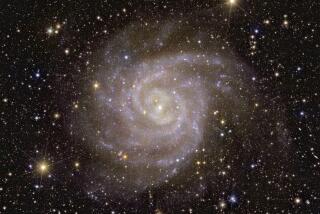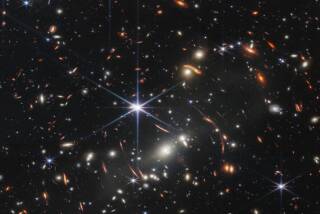Hubble harnesses gravity to find dim, ancient galaxies near big bang
If you’re a giant space telescope squinting into the far reaches of the cosmos, gravity is your best friend. Using the magnifying powers of massive galaxy clusters, three of NASA’s Great Observatories – the Hubble, Spitzer and Chandra space telescopes – are joining forces to discover some of the earliest galaxies in the universe.
This effort, called Frontier Fields, released early results this week at the American Astronomical Society meeting in Maryland.
The Hubble Space Telescope has been looking deep into the distant reaches of the universe, because the longer the light has traveled, the older the image we see is -- and the closer to the big bang it must be. Scientists want to understand these galaxies and their stellar contents in order to better understand the origins of our universe, which was born 13.8 billion years ago.
But the light from these distant galaxies is incredibly faint – so much so that, beyond a certain point, it’s difficult to pick it up in wavelengths beyond infrared. NASA’s James Webb Space Telescope could potentially open up this time period in cosmic history, but that observatory won’t launch until 2018.
Luckily, astronomers can take advantage of a phenomenon known as gravitational lensing. Extremely massive objects can cause light to bend around them, just like a magnifying glass, making the objects appear many times brighter than they would normally – and allowing astronomers to study objects that would be impossible to see otherwise.
Using Hubble, a team of astronomers looked at a 3.5-billion-year-old galaxy cluster known as Abell 2744, or Pandora’s cluster. Abell 2744 is the result of at least four galaxies crashing together, and contains trillions of stars – and that’s just what we see. About 75% of its mass is invisible, in the form of mysterious dark matter. This incredibly bulky intergalactic mash-up then bent the light from very distant galaxies behind it – galaxies that are 12 billion years old.
Using Pandora’s galactic box, they opened up a field of view filled with nearly 3,000 distant galaxies – some dwarfs that were a thousandth the Milky Way’s mass, some massive monsters that were 100 times our galaxy’s mass. These galaxies were 10 to 20 times brighter than they would be without Abell 2744, astronomers said.
On the flip side, scientists can also learn more about Abell 2744 – specifically, all the dark matter in it – by studying these distant, magnified galaxies. By watching the way that Pandora’s cluster distorts the background light, scientists will be able to map out the dark matter’s mass.
Another extremely massive galaxy cluster known as Abell 1689 allowed Hubble to take a peek at 58 tiny, dim galaxies from 10 billion years ago. Abell 1689’s powers of magnification made them 100 times brighter – and they turned out to be roughly 100 times more numerous than their brighter peers.
Though scientists have been picking up only relatively brighter galaxies from the distant past, the results show that the dimmest, smallest galaxies might actually have been making most of the stars during this period in the universe’s history.
Astronomers are making a mad dash to study this time period, with whatever means possible. Hubble is also picking up surprisingly bright galaxies that are more than 13 billion years old – they’re so luminous that they can potentially be observed with ground-based telescopes.
ALSO:
A hunt for dark matter in a former gold mine
Bright, ancient galaxies offer a rare glimpse of the early universe
Doggie “doo” north? Dogs sense Earth’s magnetic field while pooping: study
Space geckos! Sticky-footed robots could climb future spacecraft
So crazy it might work? Meet NASA’s ‘super ball bot’







